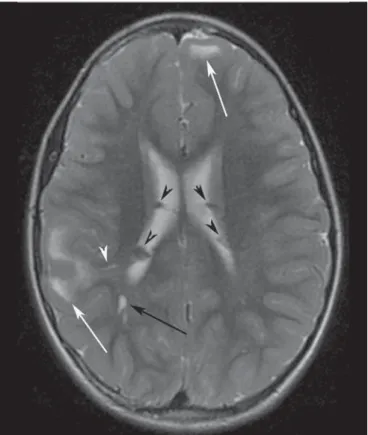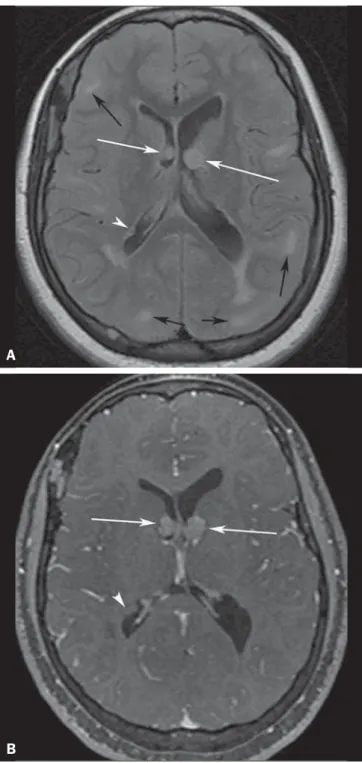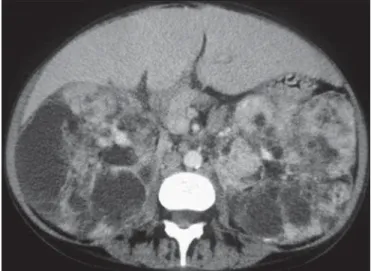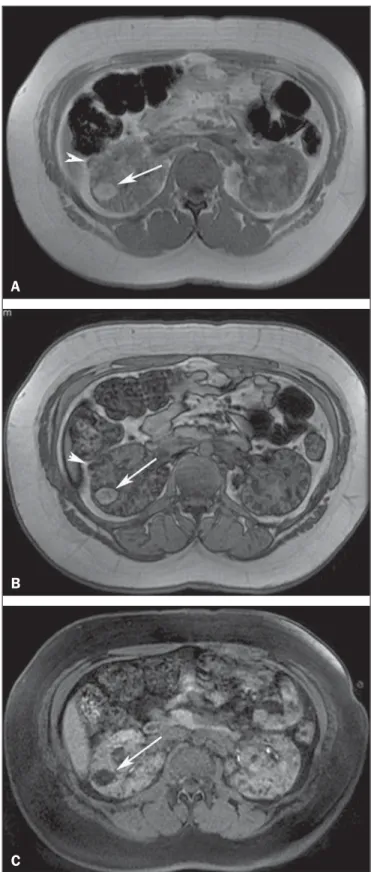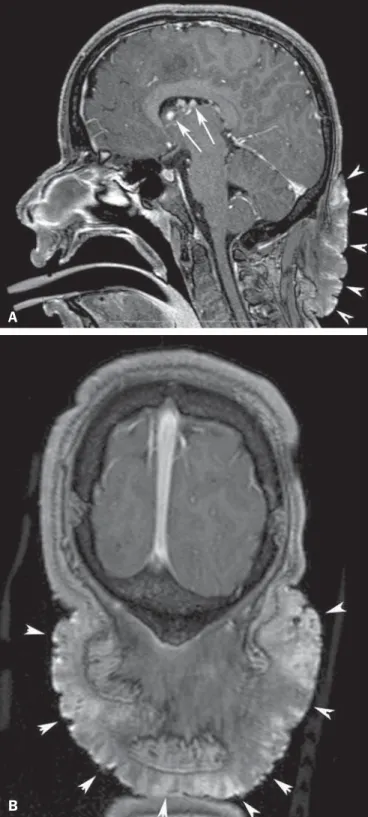von Ranke FM et al. / Imaging of tuberous sclerosis complex
Radiol Bras. 2017 Jan/Fev;50(1):48–54 48
Pictorial Essay
Imaging of tuberous sclerosis complex: a pictorial review
Aspectos de imagem do complexo esclerose tuberosa: ensaio iconográfico
von Ranke FM, Faria IM, Zanetti G, Hochhegger B, Souza Jr AS, Marchiori E. Imaging of tuberous sclerosis complex: a pictorial review. Radiol Bras. 2017 Jan/Fev;50(1):48–54.
Abstract
R e s u m o
Tuberous sclerosis complex (TSC) is a genetically determined hamartomatous neurocutaneous disease with high phenotypic variability. TSC is characterized by widespread hamartomas and benign, or rarely malignant, neoplasms distributed in several organs throughout the body, especially in the brain, skin, retina, kidney, heart, and lung. Common manifestations include cortical tubers, subependymal nodules, white matter abnormalities, retinal abnormalities, cardiac rhabdomyoma, lymphangioleiomyomatosis, renal angiomyolipoma, and skin lesions. The wide range of organs affected by the disease implies that TSC1 and TSC2 genes play important roles in the regulation of cell proliferation and differentiation. Although recent advances in treatment have improved morbidity, the prognosis remains quite poor and nearly 40% of patients die by the age of 35 years. Imaging is important in the evaluation of TSC because of its role not only in presumptive diagnosis, but also in defining the full extent of involvement. This information allows a better understanding of the behavioural phenotype, as related to lesion location. Imaging also contributes to treatment planning. This pictorial review describes common and uncommon imaging manifestations of TSC.
Keywords: Tuberous sclerosis; Computed tomography; Magnetic resonance imaging.
Complexo esclerose tuberosa (CET) é uma síndrome hamartomatosa neurocutânea geneticamente determinada, com elevada variabi-lidade fenotípica. O CET é caracterizado por hamartomas generalizados e pela presença de neoplasias benignas, ou raramente malignas, acometendo vários órgãos, especialmente cérebro, pele, retina, rins, coração e pulmões. As manifestações mais comuns incluem tubér-culos corticais, nódulos subependimais, anormalidades na substância branca, anormalidades da retina, rabdomioma cardíaco, linfangio-leiomiomatose, angiomiolipoma renal e lesões de pele. A ampla gama de órgãos afetados sugere que genes TSC1 e TSC2 desempenham papel importante na regulação da proliferação e diferenciação celular. Apesar de os recentes avanços no tratamento terem melhorado a morbidade, o prognóstico permanece bastante ruim e cerca de 40% dos pacientes morrem próximo aos 35 anos de idade. Estudos por imagem são importantes na avaliação do CET, em razão do seu papel não só no diagnóstico presuntivo, mas também na definição da extensão total da doença. Estas informações permitem uma melhor compreensão do fenótipo comportamental, relacionado com a localização das lesões. A imagem auxilia, também, no planejamento do tratamento. . Este ensaio pictórico descreve as manifestações de imagem comuns e incomuns do CET.
Unitermos: Esclerose tuberosa; Tomografia computadorizada; Ressonância magnética.
Study conducted at the Universidade Federal do Rio de Janeiro (UFRJ), Rio de Janeiro, RJ, Brazil.
1. MD, Universidade Federal do Rio de Janeiro (UFRJ), Rio de Janeiro, RJ, Brazil. 2. MD, PhD, Universidade Federal do Rio de Janeiro (UFRJ), Rio de Janeiro, RJ, Brazil.
3. MD, PhD, Santa Casa de Porto Alegre, Porto Alegre, RS, Brazil.
4. MD, PhD, Faculdade de Medicina de São José do Rio Preto (Famerp) and Ultra X, São José do Rio Preto, SP, Brazil.
Mailing address: Dr. Edson Marchiori. Rua Thomaz Cameron, 438, Valparaíso. Petrópolis, RJ, Brazil, 25685-120. E-mail: edmarchiori@gmail.com.
Received January 5, 2016. Accepted after revision February 14, 2016.
consists of facial adenoma sebaceum, epilepsy, and mental retardation(3). The presence of common manifestations,
in-cluding cortical tubers or subependymal nodules, white matter (WM) abnormalities, retinal abnormalities, cardiac rhabdomyoma, lymphangioleiomyomatosis (LAM), and re-nal angiomyolipoma (AML), allows confirmation of the di-agnosis, especially when associated with skin lesions(4).
Imaging is important in the evaluation of TSC because of its roles not only in presumptive diagnosis, but in defining the full extent of involvement. Imaging also contributes to treatment planning.
DIAGNOSIS
The demonstration of a pathogenic mutation in the TSC1 or TSC2 gene in normal tissue is now considered sufficient for the diagnosis of TSC, independent of clinical manifesta-tions(5). Clinical diagnostic criteria are important, however,
because genetic testing may not identify a mutation in up to 25% of patients. The clinical criteria are divided into major
Felipe Mussi von Ranke1, Igor Murad Faria1, Gláucia Zanetti2, Bruno Hochhegger3, Arthur Soares Souza Jr.4, Edson Marchiori2
INTRODUCTION
Tuberous sclerosis complex (TSC) is a genetically de-termined multisystem hamartomatous neurocutaneous dis-ease. The organs most commonly involved are the brain, skin, kidney, lung, retina, and heart(1). The wide range of organs
and minor features, with definitive diagnosis defined by the presence of at least two major features or one major and two minor features. The diagnosis of TSC is considered possi-ble in the presence of one major or two or more minor fea-tures(5).
INTRACRANIAL MANIFESTATIONS Cortical tubers
The expansive lesions of the central nervous system alone are not diagnostic of TSC and may be seen in other patho-logical conditions(6–10).
Cortical tubers are benign hamartomas detectable in the cerebral cortex in approximately 95% of patients with TSC(4).
They are considered to be related closely to the neurologi-cal manifestations of TSC, including epilepsy, cognitive disability, and neurobehavioural abnormalities(4). On
mag-netic resonance imaging (MRI), cortical tubers typically appear as well-circumscribed areas of low signal intensity on T1-weighted and high signal intensity on T2-weighted sequences(11) (Figures 1 and 2).
Subependymal nodules
Subependymal nodules are common brain lesions found in patients with TSC, which represent hamartomatous growths. Typically benign, subependymal nodules can degen-erate into subependymal giant cell astrocytomas (SEGAs)(11). Computed tomography (CT) is useful for the detection of subependymal nodules, as they are associated with calcifica-tion far more commonly (88%) than are cortical tubers(4).
On MRI, subependymal nodules show intermediate signal intensity on T1-weighted images and isointense to hyperin-tense signals on T2-weighted images(3,4) (Figure 2). Subependymal giant cell astrocytomas
SEGAs are widely accepted to be derived from subep-endymal nodules(2). The prognosis is generally good, as
SEGAs grow slowly. However, SEGA growth may result in ventricular obstruction and hydrocephalus(4). SEGAs are
hypo- to isointense compared with cortex on T1-weighted images and heterogeneously iso- to hyperintense on T2-weighted images(3) (Figure 3).
White matter abnormalities
WM abnormalities in TSC include superficial abnor-malities associated with cortical tubers, radial migration lines (RMLs), and cyst-like WM lesions. On MRI, superficial WM abnormalities are seen as hyperintense areas on T2-weighted images and hypointense areas on T1-weighted images (Fig-ure 1). RMLs appear as thin, straight or curvilinear bands of hyperintensity on T2-weighted images and show iso- to hypointensity on T1-weighted sequences. Cyst-like WM le-sions are small well-demarcated lele-sions with intensity simi-lar to that of cerebrospinal fluid. They are seen in deep WM, typically near the lateral ventricles(4,11).
Figure 2. A 12-year-old boy with tuberous sclerosis complex. Axial T2-weighted image shows cortical tubers as well-circumscribed areas of high signal intensity (white arrows) and subependymal nodules along the ventricular surface (black arrowheads). Note radial migration line appearing as a thin, straight band of hyperintensity extending from the juxtaventricular white matter to the cortex (black arrow), and white matter cyst-like lesion located in deep white matter near the atrium of the right lateral ventricle (white arrowhead).
PULMONARY MANIFESTATIONS Lymphangioleiomyomatosis
LAM is a rare disorder that often occurs in patients with TSC (TSC-LAM). A rare sporadic form (S-LAM) affects the lungs, lymphatics, retroperitoneum, and kidneys(4,12).
TSC-LAM and S-TSC-LAM affect women almost exclusively and are
characterized by diffuse interstitial proliferation of smooth muscle cell bundles and cystic changes in the pulmonary pa-renchyma. The hallmark feature of LAM is the presence of diffuse, well-circumscribed, thin-walled lung cysts distributed uniformly throughout the lungs(4,12) (Figure 4). Clinically,
Figure 3. A 23-year-old woman with tuberous sclerosis complex and subepend-ymal giant cell astrocytomas. Axial fluid-attenuation inversion-recovery image (A) shows heterogeneous hyperintense masses (subependymal giant cell astrocyto-mas) located at the frontal horn of the lateral ventricles, near the foramen of Monro (white arrows). Axial contrast-enhanced T1-weighted image (B) shows strong and heterogeneous enhancement of the lesions (white arrows). Note also cortical tubers (black arrows), and subependymal nodule along the right lateral ventricular surface (arrowheads), best depicted on fluid-attenuation inversion-re-covery image.
A
B
Figure 4. A 52-year-old woman with tuberous sclerosis complex. Axial (A,B) and coronal (C) CT mini–maximum-intensity projection images show numerous bilat-eral, variably sized thin-walled cysts, compatible with lymphangioleiomyomatosis.
LAM is characterized by progressive dyspnoea on exertion, recurrent pneumothoraces (Figure 5), and abdominal tumors, including AMLs and lymphangiomyomas(4,12).
Pneumothorax and chylous pleural effusion are the two major complications of pulmonary LAM(4).
Multifocal micronodular pneumocyte hyperplasia
Multifocal micronodular pneumocyte hyperplasia is the second lung manifestation in TSC. It is a rare pulmonary disorder characterized by multicentric, well-demarcated nodular proliferation of type II pneumocytes along alveolar septa(5). Multifocal micronodular pneumocyte hyperplasia
is characterized on high-resolution CT by multiple non-cal-cified pulmonary nodules or nodular ground-glass opacities ranging in size from 2 mm to 1 cm, scattered diffusely and randomly throughout the lung(12).
CARDIAC MANIFESTATIONS
Cardiac rhabdomyoma is a benign striated muscle tumor and the most common cardiac tumor in children(4,5,13). It
occurs in about 60% of children, but only 20% of adults, with TSC(4,5,13,14). Most rhabdomyomas are asymptomatic, with a minority of patients experiencing arrhythmia and/or car-diac failure(1,5). Echocardiography has been established as
the primary diagnostic tool for the evaluation of cardiac rhab-domyomas in children(3,4). CT or MRI can provide additional information regarding tumour extension or size, especially in older patients or those from whom echocardiographic images are poor due to bone or lung interference(4). RENAL MANIFESTATIONS
Renal angiomyolipoma
AMLs are the most common mesenchymal renal neo-plasms. They occur as isolated, sporadic entities in 80% of cases, most commonly manifesting in middle-aged women(10).
The other 20% of AMLs develop in association with TSC.
AMLs are found in70–80% of patients with TSC(4,5,13–15).
The most alarming complication of renal AMLs is rupture, due to their abnormal vasculature, associated frequently with aneurysms(2,13,14) (Figure 6). CT permits the diagnosis of
renal AML by demonstrating the presence of intratumoral fat (Figure 7). Attenuation < –20 HU is a characteristic find-ing of AML in unenhanced CT examination(4,15). AMLs with
a predominant fatty component are isointense relative to fat on all MRI sequences(3); their signal intensity is typically
higher than that of the renal parenchyma on T1-weighted images, and homogeneous and high on T2-weighted im-ages(3,4) (Figure 8).
Renal cell carcinoma
Renal cell carcinoma (RCC) is a rare manifestation in patients with TSC, with an estimated incidence of 2–4%,
Figure 5. A 52-year-old woman with tuberous sclerosis complex presenting with sudden onset of right chest pain and dyspnoea. Axial CT image obtained with the lung window setting shows right-sided pneumothorax and numerous thin-walled cysts scattered throughout the lungs, compatible with lymphangioleiomyomatosis.
Figure 6. A 38-year-old man with tuberous sclerosis complex and renal lipid-poor angiomyolipoma. Axial contrast-enhanced CT image shows a large, high-attenu-ation, enhancing heterogeneous tumour with an aneurysm in the right kidney (ar-row). This patient also had a small lipid-poor angiomyolipoma in the left kidney (arrowhead).
which is nonetheless higher than in the general popula-tion(1,13,15,16). Imaging findings depend on RCC subtype. Clear cell RCC, the most common subtype, shows hypo- to isointensity on T1-weighted images and iso- to hyperintensity on T2-weighted images(2–4). Papillary RCC commonly
dem-onstrates low signal intensity on T2-weighted images and tends to exhibit hypovascular and homogeneous enhance-ment, which can be difficult to differentiate from that of li-pid-poor AMLs(4,15).
OTHER MANIFESTATIONS
Detection of characteristic dermatological lesions, which can appear anytime during childhood, is important in the diagnosis of TSC. The most common lesions are hypomelanotic macules, angiofibromas, shagreen patches (Figure 9), forehead plaques, and ungual fibromas(2,5).
The involvement of various abdominal organs, includ-ing the alimentary tract, hepatobiliary system, and pancreas, has been reported in patients with TSC. Hepatobiliary le-sions, including hepatomegaly, AMLs, lipomas, hamartomas, and fibromas, have been described in patients with TSC. Most hepatic AMLs are sporadic(4). The incidence of hepatic AML (Figure 10) is much lower than that of renal AML in pa-tients with TSC(5). Skeletal abnormalities in TSC include
cyst-like lesions, hyperostosis of the inner table of the cal-varia, osteosclerotic changes (Figure 11), periosteal new bone formation, cystic changes in the phalanges, and scol-iosis(3). These bone abnormalities can also be seen in
sev-eral other diaseases(17–22), and only in the presence of changes
in other organs that fulfill TSC criteria can be associated with the complex. Retinal hamartomas are present in about 40–50% of patients with TSC. When retinal hamartomas have calcification, ultrasound, CT, and MRI can show these le-sions(2).
REFERENCES
1. Curatolo P, Bombardieri R, Jozwiak S. Tuberous sclerosis. Lancet. 2008;372:657–68.
2. Crino PB, Nathanson KL, Henske EP. The tuberous sclerosis com-plex. N Engl J Med. 2006;355:1345–56.
3. Evans JC, Curtis J. The radiological appearances of tuberous scle-rosis. Br J Radiol. 2000;73:91–8.
4. Umeoka S, Koyama T, Miki Y, et al. Pictorial review of tuberous sclerosis in various organs. Radiographics. 2008;28:e32. 5. Northrup H, Krueger DA; International Tuberous Sclerosis
Com-plex Consensus Group. Tuberous sclerosis comCom-plex diagnostic cri-teria update: recommendations of the 2012 International Tuber-ous Sclerosis Complex Consensus Conference. Pediatr Neurol. 2013;49:243–54.
6. Destefani MH, Mello AS, Oliveira RS, et al. Chordoid glioma of the third ventricle. Radiol Bras. 2015;48:338–9.
7. Machado VS, Silva Junior NA, Queiroz LS, et al. Central nervous system involvement in sarcoidosis. Radiol Bras. 2015;48:334–5. 8. Schwingel R, Duarte SBL, Oshima MM, et al. Multiple
hemangio-blastomas, association with von Hippel-Lindau syndrome. Radiol Bras. 2015:48(2):xi–xiii.
9. Dultra AHA, Noro F, Melo ASA, et al. Primary intercavernous lym-phoma of the central nervous system. Radiol Bras. 2015;48:337–8.
Figure 8. A 21-year-old woman with tuberous sclerosis complex and multiple renal angiomyolipomas. T1-weighted in-phase gradient-recalled echo image (A) shows a hyperintense right renal mass (arrow). T1-weighted opposed-phase gra-dient-recalled echo image (B) shows a peripheral India ink artefact at the fat– water interface between the mass and surrounding normal renal parenchyma, a finding diagnostic of lipid-rich angiomyolipoma. T1-weighted fat-suppressed im-age (C) shows diffuse intralesional low signal intensity in the lipid-rich angiomyolipoma. Note also a lipid-poor angiomyolipoma in the right kidney, ap-pearing as a hyperintense nodular lesion in (A) (arrowhead) and presenting homo-geneous internal signal loss in (B) (arrowhead) due to the presence of micro-scopic amounts of fat within the lesion.
A
B
Figure 10. A 27-year-old man with tuberous sclerosis complex. Axial unenhanced CT image shows two well-defined nodular lesions with fat attenuation (arrows) in the liver, compatible with angiomyolipomas.
Figure 11. A 22-year-old woman with tuberous sclerosis complex and sclerotic spinal bone lesions. Axial CT images at the T5 (A) and T8 (B) levels demonstrate round, oval, and elongated sclerotic bone lesions on the anterior aspects of the vertebral bodies, pedicles, laminas, and transverse and spinous processes.
A
B
10. Sharma R, Gupta P, Mahajan M, et al. Giant nontraumatic intra-diploic arachnoid cyst in a young male. Radiol Bras. 2016;49:337– 9.
11. Kalantari BN, Salamon N. Neuroimaging of tuberous sclerosis: spec-trum of pathologic findings and frontiers in imaging. AJR Am J Roentgenol. 2008;190:W304–9.
12. Franz DN, Brody A, Meyer C, et al. Mutational and radiographic analysis of pulmonary disease consistent with lymphangioleiomyo-matosis and micronodular pneumocyte hyperplasia in women with tuberous sclerosis. Am J Respir Crit Care Med. 2001;164:661–8.
Figure 9. A 13-year-old boy with tuberous sclerosis complex. Sagittal (A) and coronal (B) T1-weighted images with gadolinium enhancement show a large, pro-tuberant, irregularly thickened, elevated skin patch with an irregular border in the dorsal cervical region, consistent with shagreen patch (arrowheads). Note also in (A) enhancing subependymal nodules (arrows) projecting into the lumen of the lateral ventricle in the region of the foramen of Monro.
A
13. De Waele L, Lagae L, Mekahli D. Tuberous sclerosis complex: the past and the future. Pediatr Nephrol. 2015;30:1771–80. 14. Leung AK, Robson WL. Tuberous sclerosis complex: a review. J
Pediatr Health Care. 2007;21:108–14.
15. Manoukian SB, Kowal DJ. Comprehensive imaging manifestations of tuberous sclerosis. AJR Am J Roentgenol. 2015;204:933–43. 16. Muglia VF, Prando A. Renal cell carcinoma: histological
classifica-tion and correlaclassifica-tion with imaging findings. Radiol Bras. 2015;48: 166–74.
17. Braun RA, Milito CFRB, Goldman SM, et al. Ivory vertebra: imag-ing findimag-ings in different diagnoses. Radiol Bras. 2016;49:117–21. 18. Andrade Neto F, Teixeira MJD, Araújo LHC, et al. Knee bone tu-mors: findings on conventional radiology. Radiol Bras. 2016;49:182– 9.
19. Lima Júnior FVA, Savarese LG, Monsignore LM, et al. Computed tomography findings of paracoccidiodomycosis in musculoskeletal system. Radiol Bras. 2015;48:1–6.
20. Petrilli M, Senerchia AA, Petrilli AS, et al. Computed tomography-guided percutaneous trephine removal of the nidus in osteoid os-teoma patients: experience of a single center in Brazil. Radiol Bras. 2015;48:211–5.
21. Franca PMV, Ferrreira CS, Figueiredo R, et al. Melorheostosis. Radiol Bras. 2015;48:60–1.
